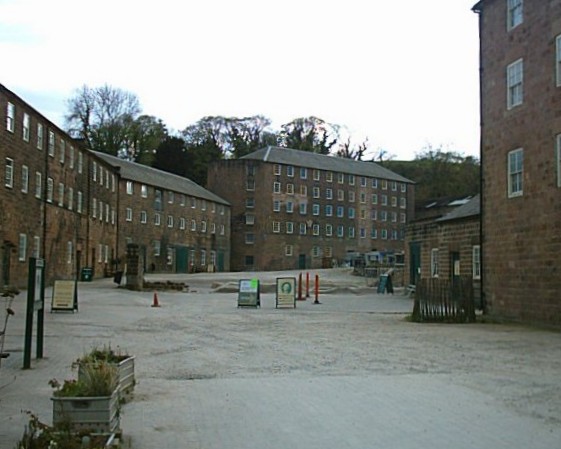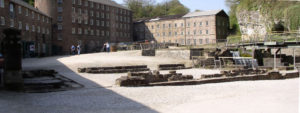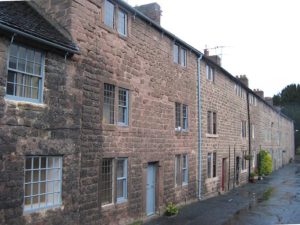Spinning Through Time: From Domesday Village to Company Town
By Gail E. Gresh

By Gregory Deryckère – Own work, CC BY 2.5, https://commons.wikimedia.org/w/index.php?curid=782780
William the Conqueror’s 11th century Domesday Book called the village Crumforde and today it is Cromford. Tucked next to the river Derwent in northern England, this tidy Derbyshire village has undergone a number of transformations from its first iteration in early medieval England, but none more significant than when inventor and industrialist Richard Arkwright (1732 – 1792) came to town in 1771. Arkwright was known as an industrialist, entrepreneur, designer of water-power driven machinery, and developer of the modern factory system. He was inventor of the water frame, as well as the spinning frame. His flying shuttle increased production of woven goods.

Flying Shuttle, Wikipedia
 By chevin – Own work, Public Domain,
By chevin – Own work, Public Domain,
Arkwright chose Cromford for his textile mill because of its access to streams that he could divert to power the machinery. Those streams tumbled down from the surrounding hills where lead was historically mined.
Cotton soon spun Cromford away from lead mining and into the industrial age. In 1771 Arkwright’s mill turned Cromford into a factory town. Grown with slave labor, raw cotton was imported from slave-owning American plantations into the port of Liverpool. All processing was now under one efficient roof (sorting, carding, spinning).
The Masson Mill Works arrived in Cromford next, hard on the heels of Arkwright’s original Cromford Mill. Tall windows gave natural light and ventilation in those pre-electricity days.
Richard Arkwright transformed Cromford into a company town which included employee housing (stone houses still in use), a church, a doctor for the workers, a school for the children. Workers even received sick pay. Housing was better than in cities, with more access to fresh air, gardens, schools, jobs. In the early years, the mill employed children as young as six, but later years employed those over ten.

Still occupied — Company housing; By Alethe – Own work, CC BY-SA 3.0,
When steam power later became available, mills could be built anywhere. Water was still important as canals were built to ease the transport of manufactured goods. The mother of modern nursing, Florence Nightingale, lived nearby in the 1800s, and her family sold some of their land for a canal.
After falling into disrepair, the Cromford mill complex, was declared by Historic England as “one of the country’s 100 irreplaceable sites.” It is also the centerpiece of the Derwent Valley Mills UNESCO World Heritage Site. Masson Mill is still in operation and visitors can see firsthand what mill life was like during the Industrial Age.
Today, Cromford is a busy town today at a crossroads on the A6. Limestone is still quarried nearby, but lead mines are long shuttered. William the Conqueror may not recognize the once sleepy village of his Domesday book.
http://www.derwentvalleymills.org/
https://whc.unesco.org/en/list/1030/
https://www.massonmills.com/Museum/